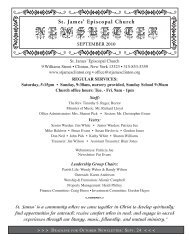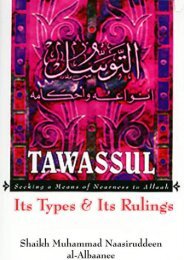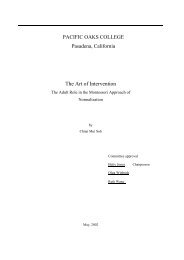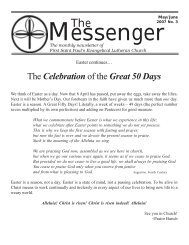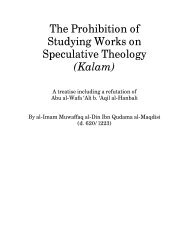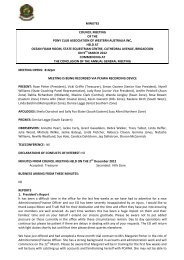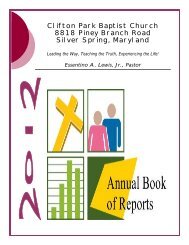Scripture and God in Christianity
Scripture and God in Christianity
Scripture and God in Christianity
You also want an ePaper? Increase the reach of your titles
YUMPU automatically turns print PDFs into web optimized ePapers that Google loves.
fer<strong>in</strong>g <strong>in</strong> the trial of death, because it was impossible for him to taste the trial of death if [the<br />
<strong>God</strong>head] were not cautiously remote from him, but also near enough to do the needful <strong>and</strong> necessary<br />
th<strong>in</strong>gs for the [human] nature that was assumed by it." 674 He further argued that while the<br />
scriptures dist<strong>in</strong>guishes the natures, it at the same time stresses the unity between them. Therefore,<br />
he argued, "we po<strong>in</strong>t to difference of natures, but to unity of Person" or <strong>in</strong> other words "the<br />
two natures are, through their connection, apprehended to be one reality." 675<br />
As we see, Theodore emphatically denies the transformation or transmutation of the Logos <strong>in</strong>to<br />
flesh. He also held that the div<strong>in</strong>e nature did not change the human nature. Jesus, hav<strong>in</strong>g human<br />
nature, by grace <strong>and</strong> free will could follow the div<strong>in</strong>e nature. Therefore, one could say that Mary<br />
gave birth to <strong>God</strong>.<br />
Theodore's opponents opposed this theory as lead<strong>in</strong>g to a "monster with two heads", a be<strong>in</strong>g with<br />
two personal centers <strong>and</strong> a comb<strong>in</strong>ation of two sons. 676 Theodore denied this as mere accusation<br />
but, to McGiffert, "to all <strong>in</strong>tents <strong>and</strong> purpose he was do<strong>in</strong>g so." 677 Cyril of Alex<strong>and</strong>ria s<strong>in</strong>gled<br />
him out for attack <strong>and</strong> s<strong>in</strong>ce the Fifth General Council of Constant<strong>in</strong>ople <strong>in</strong> 533 he has been labeled<br />
as a Nestorian before Nestorius. Modern scholarship v<strong>in</strong>dicates him of this accusation as<br />
Kelly observes: "In modern times, especially s<strong>in</strong>ce the rediscovery of the relatively <strong>in</strong>nocuous<br />
Catechetical Homilies, there has been a decided reaction aga<strong>in</strong>st this verdict. It has been emphasized,<br />
for example, that he was deeply concerned, so far as his categories of thought allowed, to<br />
establish the oneness of subject <strong>in</strong> the <strong>God</strong>-man....He can write, for example, `Thus there results<br />
neither any confusion of the natures nor any untenable division of the Person; for our account of<br />
the natures must rema<strong>in</strong> unfocused, <strong>and</strong> the Person must be recognized as <strong>in</strong>divisible'; <strong>and</strong> aga<strong>in</strong>,<br />
`We display a dist<strong>in</strong>ction of natures, but unity of Person'. For these <strong>and</strong> similar reasons the traditional<br />
estimate has been replaced by a more appreciative one which views him primarily as a<br />
theologian who championed the reality of the Lord's manhood aga<strong>in</strong>st Apoll<strong>in</strong>arianism <strong>and</strong> strove<br />
to do justice to His human experience." 678 F. Young observes that "If Theodore stresses the duality,<br />
it is because for him the unity is obvious." 679<br />
Controversy came to a head <strong>in</strong> the fifth century when Nestorius, a younger member of the Antiochian<br />
school, became bishop of Constant<strong>in</strong>ople (428 A.D.). He protested aga<strong>in</strong>st the tendency<br />
very common among the masses, especially among the monks <strong>in</strong> the neighborhood of the capital,<br />
to exalt the Virg<strong>in</strong> Mary as "Mother of <strong>God</strong>" or "theotokos". "<strong>God</strong> cannot have a mother, he argued,<br />
<strong>and</strong> no creature could have engendered the <strong>God</strong>head; Mary bore a man, the vehicle of div<strong>in</strong>ity<br />
but not <strong>God</strong>. The <strong>God</strong>head cannot have been carried for n<strong>in</strong>e months <strong>in</strong> a woman's womb,<br />
or have been wrapped <strong>in</strong> baby-clothes, or have suffered, died <strong>and</strong> been buried." 680 H. Chadwick<br />
observes that "Noth<strong>in</strong>g caused so much sc<strong>and</strong>al as a remark of Nestorius that '<strong>God</strong> is not a baby<br />
two or three months old.' " 681 Nestorius held that she should either be called 'mother of the man<br />
Jesus' or 'mother of Christ'. His objection was to the transference of human attributes to the div<strong>in</strong>e<br />
Logos. He emphatically denied that the Logos participated <strong>in</strong> the suffer<strong>in</strong>gs of the human<br />
nature of Christ. 682<br />
He believed that Jesus had two natures. He ma<strong>in</strong>ta<strong>in</strong>ed that before the union of the man <strong>and</strong> the<br />
Logos <strong>in</strong> Jesus, the man was a person dist<strong>in</strong>ct from Logos. Then "He who is the similitude of<br />
<strong>God</strong> has taken the person of the flesh." 683 After the union these two separate persons reta<strong>in</strong>ed<br />
84





